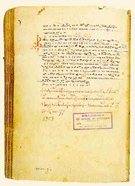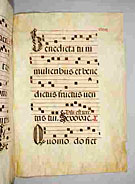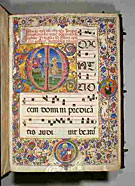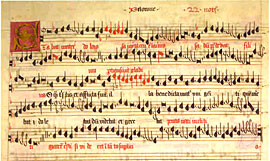The notations that can be seen in manuscripts of liturgical music tell a story in themselves. They are often as beautiful as the illuminations, and look far different from their modern counterparts. From the earliest to the later shapes we can trace some of the main streams of music. What a world of sound and beauty is contained in even the simplest forms!
Beginnings. The beginnings of western notation are to be found in the grammatical accents of Greek: the acute accent [ / ] for a rise of the voice, and the grave accent [ \ ] for a fall; in combination, the circumflex [  ] indicated a rise and fall, the anticircumflex [
] indicated a rise and fall, the anticircumflex [  ] a fall and rise. More extended groupings increased the possibilities of combinations.
] a fall and rise. More extended groupings increased the possibilities of combinations.
"Gospel of Mark," 10th Century from "Neumes" by Rich Elliott. Click on image for larger view.
Neumes. Out of these accents evolved a system for notating Plainsong or Gregorian Chant which strongly resembles stenographic symbols. Knows as neumes (from the Greek neuma, a nod or sign), they indicated the outlines of a melody. The earliest complete manuscripts containing neumes come from the 9th century, although fragments exist from the 8th. These are already so well developed that it is believed they must have originated by the 6th century.
In the development of neume notation the acute accent became the virga, written as a stroke and usually slanting to the right. The grave accent became the punctum, written as a point or dot. All other neumes which are combinations of these make up the group known as accent neumes. A few others which indicate a manner of performance are called hooked neumes.
Ekphonetic. What might be described as an intermediate state is shown in the systems found in Byzantine, Armenian, Syrian, Coptic, Jewish and some Greek manuscripts. Called ekphonetic notation, it utilizes a limited number of signs for the solemn singing of a liturgical text. These are distinguished from neumes by the fact that they indicate a succession of fixed melodic patterns rather than a freely moving melody.
"Sticharion," circa 1445, Dionysiou Monastery, Greece. Click on image for larger view.
Oratorical Neumes. In the earliest manuscripts, 9th to 11th centuries, the neumes are written along a straight line. This line is sometimes drawn, but more frequently scratched or indented into the vellum (dry-point technique). Such notation could only vaguely indicate the course of a melody, serving as a memory aid to singers who had already learned it by heart or for the choirmaster in conducting it. This manner of writing neumes was called oratorical or chironomic, suggesting the upward and downward motion of the choirmasters hand, and gave no indication of the intervals between tones.
Diastemic neumes. Toward the year 1,000 we find evidence of an arrangement of the neumes to approximate the rise and fall of the melody. This was at first done without the aid of actual lines and called in campo aperto (in the open field). The Beneventan scribes of Southern Italy and those of England excelled in this. The neumes used in this intervallic notation were said to be heightened or diastemic.
Diastemic neume, manuscript from Albi, before 1079; from the Plainchant Homepage Click on image for larger view.
Oratorical neumes cannot be read with accuracy, and our knowledge of the melodies they notate comes principally from comparisons with similar forms in later intervallic notations. Their meaning becomes clearer as lines, drawn or dry-point are used to locate pitches. Sometimes letters were introduced to clarify pitch or alter rhythm. Also, the neume forms themselves could be altered for rhythmic purposes, such as being separated to indicate a slowing down.
Squared notation. All the forms that have been described underwent changes with the passage of time and as the need for greater exactness was met with improvements. By the 13th century, regional differences that could be seen earlier were less pronounced. To the School of Notre Dame in Paris (ca. 1175-1250) is attributed the first use of square notation. This form, the most familiar, is still in use today for notating Gregorian Chant. It evolved from the late Aquitanian and, to a lesser extent, the Norman. Its use spread and was gradually accepted in most of Southern and Western Europe. Austria, Germany and parts of Flanders and Holland continued to sue the Gothic into the 16th century. The square form, also know as Plainchant notation, was used to notate the large body of secular monophonic music from the 12th to 15th centuries, including melodies of the Troubadours, Trouveres, Minnesinger, Meistersinger and others.
"Antiphonal," 12th Century, Italy; from Columbia University. Click on image for larger view.
The Staff. Associated with square notation is the four-line staff which was already in use by the time this notation appeared. Guide of Arezzo (ca. 980-1050) has been credited with its invention, but it had already been used in the 10th century. He perfected and used it in conjunction with his system of solmisation (the use of syllables ut, re, mi, etc. to establish exact scale relationships). This has been used to the present, with some modifications, for sight-singing. The staff was slowly accepted and by the 12th century is found in many areas of Italy, France, Spain and England. Some German examples from this time are known, but many centers did not employ it until the 15th century. The five-line staff is associated more with polyphonic music, but there were uses of it for chant.
Clefs. In the evolution of the staff, the clefs had their origin in the identification of lines to indicate pitch. Lines were sometimes drawn, at other times scratched into the vellum. In the early manuscripts the F line was most frequently identified, and after it the C. With the establishment of the four-line staff, these letters were used as clefs, being movable, so as to accommodate the range of the melody and thus avoid the writing of leger lines. The G line is seldom identified in chant notation. Originally these clefs wee written to resemble their letter forms, but gradually became stylized into the clef markings known today. The sign resembling a check mark seen at the end of a line in most of the manuscripts is called a custos (guide) and indicates where the first note of the next line is to be found.
"Antiphonal," 15th Century, Italy; from Columbia University. Click on image for larger view.
Letter notations. Although the ancient Greeks had used letters of the alphabet to indicate pitch, little trace of this is to be found in early Christian music. In the copies of De institutione musica of Boethius are found Latin letters used in this way. Boethius did not carry this far enough to notate the complete scale, but must have influenced later theorists such as Huchbald, Odo of Cluny and Guido, all of whom incorporated letters in their systems of notation.
Syllabic notation. The anonymous author of the 9th century treatise Musica Enchiriadis, introduced a system of notation using the Greek symbol daseia (resembling a script F) combined with S or C. By using different arrangements of these, including slanting and reversing, eighteen combinations resulted, each representing a tone of the author's gamut. It was thereby possible to notate a melody accurately except for the rhythm. Added to this was a staff of five or more lines, with only the spaces between used for pitches, and with syllables of the text written on it instead of notes.
Polyphonic notation. The square form was used to notate secular melodies about 1200, when definite rhythmic values were established. During the 13th and 14th centuries there was rapid development with many changes and innovations. Two note values, longa and brevis, were accepted ca/ 1225 and the shorter semi-brevis later in the century. Of these last, two or three could replace a brevis. The establishment of exact values independent of the fhythmic modes marks the beginning of mensural notation, ca. 1260. This was restricted to ternary meter, but in the 14th century was abandoned and the basic principles of rhythm revised. The new system, expounded by Philippe de Vitry in his treatise, Ars Nova, ca. 1325, recognized duple and triple rhythms as of equal importance, and applied this to all note values. His principles remained virtually unchanged until the end of the 16th century.
"Eton Choirbook," England, circa 1490, from "John Brown: Music of the Eton Choirbook," Gimmell Records. Click on image for larger view.
Adapted from "Medieval and Renaissance Music Manuscripts"; The Toledo Museum of Art, 1953.
For those interested, sheet music editing software for Gregorian chant is available as a free download from the Gregoire web site.
- Back to Top -






